Trello Alternatives: Why Paperless Pipeline Is The Better Transaction Management Solution

Trello is one of the most widely recognized tools in project management software, with over 4.75 million users worldwide relying on its visual boards and task tracking tools to stay organized.
For general teams and individual users, it’s an accessible and flexible solution for managing a variety of workflows.
However, when it comes to the real estate industry, where transactions are fast-paced, heavily regulated, and often involve multiple stakeholders, Trello can quickly fall short.
That’s why Paperless Pipeline is one of the best Trello alternatives. It’s built specifically for real estate professionals and has earned the trust of over 90,000 brokerages by offering features that go far beyond what Trello can provide.
It doesn’t just help you organize your tasks; it also helps you run your business more efficiently, stay compliant, and close deals faster.
In this article, we’ll take an in-depth look at both Trello and Paperless Pipeline so you can determine which solution is best for your real estate team.
Understanding Trello

Trello is a web-based application designed to help individuals and teams visually organize their work. Trello has gained popularity for its simplicity and intuitive layout, making it a go-to option for professionals looking for an easy way to coordinate tasks and track progress.
The platform has satisfaction scores of around 8.3 out of 10 thanks to its easy-to-use interface.
It’s one of the most widely used project management software tools across various industries, including marketing, software development, and real estate transaction management.
Trello provides a digital workspace that looks similar to the structure of a whiteboard covered in sticky notes. It’s commonly used to structure workflows, outline priorities, and maintain oversight across team initiatives.
However, it’s important to know that Trello wasn’t built for any specific industries. Its general-purpose design makes it flexible, but also limits its effectiveness and workflows that require more tailored solutions.
Trello’s appeal is based on its ease of use. It’s useful for startups, solepreneurs, and small teams managing day-to-day tasks or creative collaborations.
However, when businesses want to scale or take on complex projects that involve multiple dependencies, compliance steps, or specialized document handling, as is often the case in real estate, the platform becomes limited.
For example, real estate teams that handle a high volume of transactions typically need structured oversight, document workflows, audit trails, and deadline tracking.
Trello is a highly visual tool that helps users organize work in a linear and collaborative format. However, while it may be suitable for general planning and coordination, it often lacks the depth and industry-specific capabilities that growing teams and specialized professionals require, particularly those operating in regulated and document-heavy environments like real estate.
What Is Paperless Pipeline?
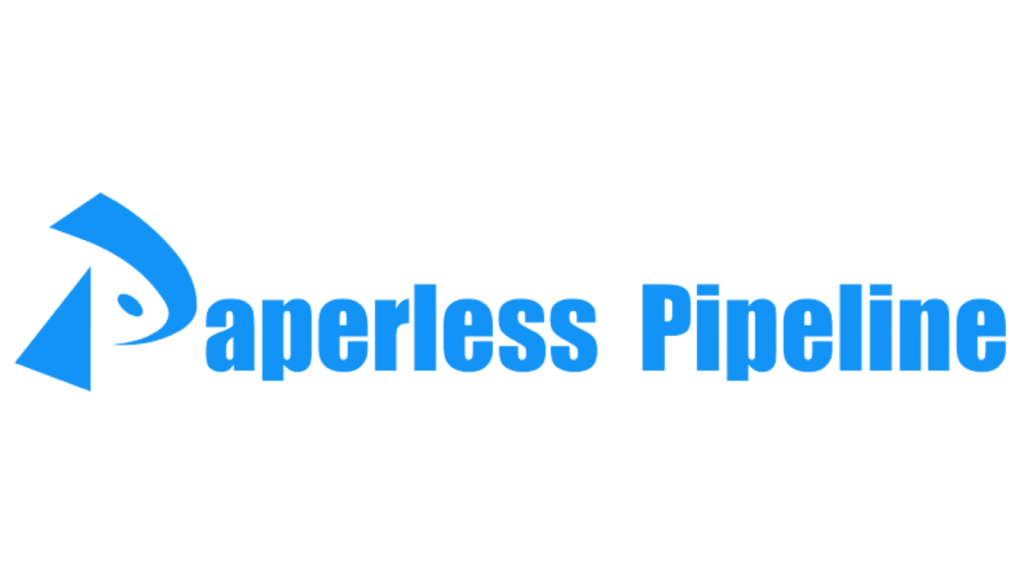
Paperless Pipeline is a transaction management platform that’s purpose-built for real estate professionals who need more than a project management tool.
The software competes within a growing real estate software market, which is expected to reach about $5 billion in 2025 and is growing annually at a roughly 15% CAGR through the next decade.
The platform is a trusted solution for hundreds of thousands of real estate teams across the United States and Canada, including brokers, transaction coordinators, admins, and agents.
Unlike general productivity apps, Paperless Pipeline was created specifically to meet the real-world demands of real estate transaction workflows where speed, accuracy, compliance, and accountability are essential.
Paperless Pipeline is more than a project management tool. It serves as a centralized hub for handling the full transaction lifecycle, from listing to close.
What makes it different from basic project management software is its deep integration with real estate workflows and its emphasis on flexibility, oversight, and compliance.
It’s designed to support not only the organization of tasks but also the operational and legal responsibilities that come with every transaction.
As it was developed with the unique needs of real estate professionals in mind, Paperless Pipeline is especially effective for teams that regularly manage complex projects involving multiple agents, clients, lenders, and documents.
Whether a brokerage is closing five deals a month or five hundred, the platform scales to accommodate volume without sacrificing efficiency or compliance.
Many real estate teams use Paperless Pipeline to streamline their internal operations, eliminate reliance on disjointed tools, and gain better control over the transaction process.
As brokerages grow, they often find that a simple project management tool can’t support their needs for advanced features, role-based access, detailed audit logs, or the ability to manage recurring tasks across deals.
Paperless Pipeline, on the other hand, is specifically designed for this type of structure, giving teams the confidence to handle more deals with less manual effort.
Lastly, Paperless Pipeline is much more than a simple task management tool. It’s a transaction management solution designed to help real estate teams close deals faster, stay compliant, and reduce the amount of manual work that often comes with high-volume operations.
Trello’s Main Features
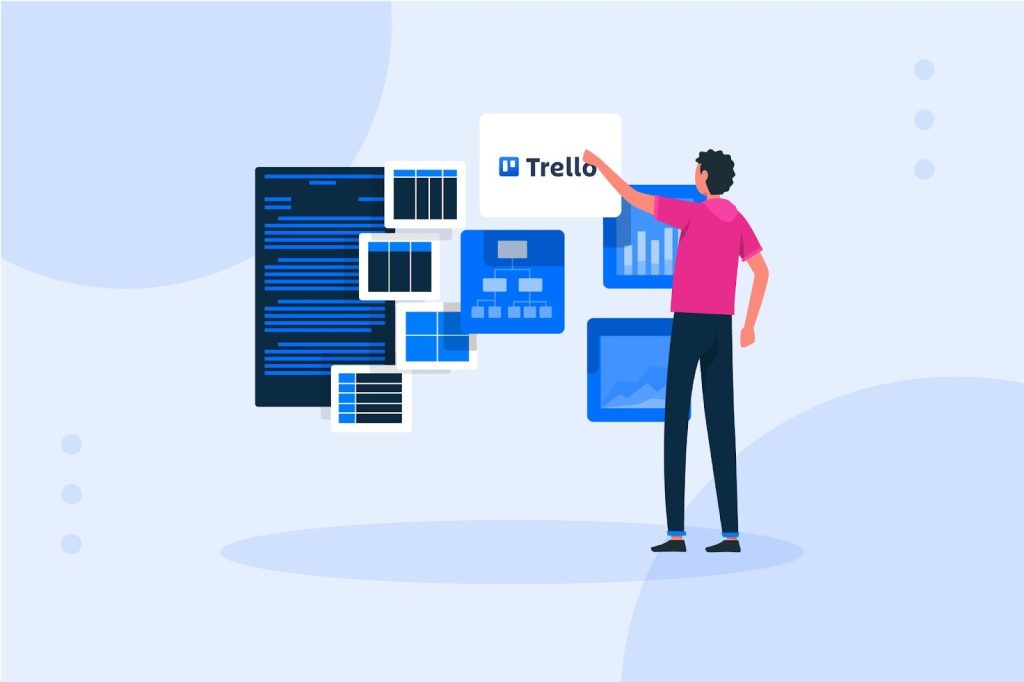
Below, we break down the core features that inform how Trello functions for its users:
Visual boards for organizing work
Trello’s most defining feature is its board-based layout. Each project workflow lives inside its own board, which provides a digital canvas where teams can visualize their work at a glance.
Boards are made up of lists, which represent stages or categories. They also include cards, which represent tasks or items of work.
This layout is particularly appealing for users who prefer to track progress visually. Instead of combing through spreadsheets or static task lists, users can get an instant snapshot of what’s in progress, what’s pending, and what’s been completed.
This board-based format mimics Kanban boards, offering momentum and movement as tasks progress through the workflow. Kanban is a visual workflow that enables teams to manage work in different stages.

Cards and lists for structured workflows
Within each Trello board, tasks are represented as cards, which can be moved between lists to reflect various workflow stages.
For example, a basic setup might include lists titled “To Do,” “In Progress,” and “Completed.” Each card can include a wide range of details, such as due dates, checklists, attachments, and links to support structured task management.
The flexibility of cards and lists enables teams to adapt Trello to almost any process, whether it’s for software development teams, marketing planning, or client onboarding.
Cards can act as individual tasks, subtasks, or even mini-projects themselves, depending on how you choose to organize them.

Unlimited boards and projects
One of the features that makes Trello attractive for project management, particularly for smaller teams and startups, is the ability to create an unlimited number of projects.
In Trello terms, this means users can create as many boards as needed, without worrying about hitting limits, particularly on the free or lower-tier plans. However, some restrictions apply to advanced functionalities.
This makes Trello a worthwhile choice for teams that want to manage multiple projects or initiatives simultaneously.
Whether tracking different clients, departments, campaigns, or goals, each can have its own dedicated space, free from interference from others.
Agile project management support
While Trello wasn’t built exclusively for software teams, it has found a strong user base among Agile users. With the right configuration, Trello can serve as a lightweight solution for Agile project management.
Teams can create backlogs, sprints, and a task queue by using boards and lists. Labels and filters make it easy to track sprint progress or prioritize tickets based on story points or issue type.
Many development teams also integrate Trello with tools like Jira, GitHub, or Slack to ensure continuity between development and communication workflows.
While Trello lacks some of the built-in automation and analytics of heavier Agile platforms, its simplicity and customization make it a good choice for teams looking for a visual alternative to traditional Agile tools.

Task assignment and role management
As you know, team productivity means ensuring everyone knows what they’re responsible for. Trello makes this easier with its ability to assign tasks to individual team members by simply tagging users on cards.
Once assigned, users can see all the tasks they’re responsible for on their personal dashboards by filtering the board.
Beyond task assignment, Trello also supports different permission levels at the board, team, and workspace levels. This ensures the right users can modify, comment on, or view certain content. This is useful for protecting sensitive information or managing external collaborators.
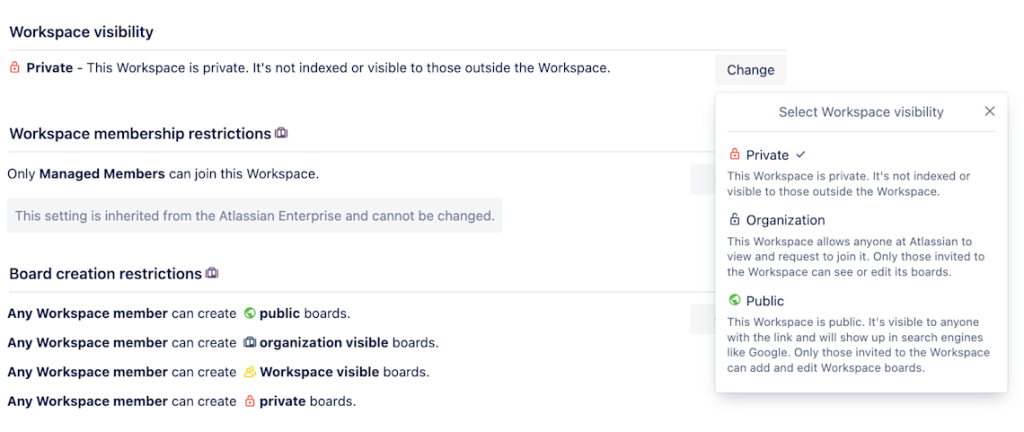
Due dates, reminders, and checklists
To help users stay on track and meet deadlines, Trello offers several tools to manage time and the completion of tasks.
Due dates can be added to any card and will trigger notifications and reminders as the deadline approaches. These reminders can be configured to alert users by email or in-app.
Each card also supports checklists, which allow tasks to be broken down into smaller, actionable steps. This is particularly helpful for recurring workflows, onboarding processes, or any task that involves multiple stages.
Users can monitor checklist completion progress directly on the card preview, providing a clearer view of project progress across the board.

Labels, tags, and filters for organization
As boards become more complex, Trello provides several methods to keep information organized. Labels can be color-coded and customized with text to indicate priority, category, department, or task type, which is essential for project organization.
Tags and filters make it easier to isolate relevant cards for an assigned user, due date, label, or keyword.
This system enhances clarity, especially since boards can contain dozens or even hundreds of active cards. It ensures that team members can quickly find what they need without sorting through irrelevant tasks, which improves efficiency.
Calendar, timeline, and table views
In addition to the traditional board view, Trello offers several other ways to visualize work.
Calendar View shows tasks and due dates in a monthly format, which helps users plan workloads and avoid conflicting deadlines.
The Timeline View is more appropriate for long-term planning and capacity forecasting, offering a Gantt chart-like layout where tasks can be mapped over days or weeks.
The Table View consolidates cards from multiple boards into a spreadsheet-style layout, allowing for high-level reporting and management. These views are useful for managers and coordinators who oversee multiple projects and teams simultaneously and need an efficient way to monitor project progress across different departments or clients.
Built-in automations
Trello includes a native automation tool called Butler, which allows users to create custom rules, buttons, and commands without needing to write code.
For example, users can automate repetitive actions when managing tasks, like moving a card when a checklist is completed, adding a label when a due date is set, or notifying a user when a card enters a specific list.
This automation engine helps team members reduce manual work and implement consistency across workflows and project timelines, particularly for recurring tasks such as approvals, notifications, or follow-ups.
Butler can also integrate with email clients or Slack to ensure that updates are delivered to the right channels.
Customizable project templates
To streamline onboarding and consistency, Trello allows users to create and share project templates. These templates can include pre-set lists, cards, labels, checklists, and workflows that reflect a team’s standard operating procedures (SOPs).
Templates reduce setup time and reduce the need to re-enter task details to ensure that every project starts with the right structure in place.
Trello also offers a public template gallery with pre-built boards for content calendars, product launches, and HR processes.
Team members can use these templates as-is or customize them to suit their needs, making it easier to maintain a unified process.

Power-ups for third-party integrations
Trello’s “Power-Ups” system enables users to integrate the platform with a wide variety of third-party tools.
These include file storage systems like Google Drive or Dropbox, communication tools such as Slack or Microsoft Teams, and productivity platforms like Salesforce or Evernote.
Each board can be improved with specific Power-Ups to bring in additional functionality as needed.
Power-Ups are helpful for teams that work across multiple systems and need to bring their data together in one place. This helps centralize information and reduce time spent switching between apps, creating a more seamless experience for team collaboration.

Mobile and cross-platform accessibility
Trello offers mobile apps for both iOS and Android, allowing users to stay connected and manage their boards from anywhere.
The mobile interface closely mirrors the project management experience on desktop and supports all major functionality, including moving cards, adding comments, uploading attachments, and using Power-Ups.
In addition to mobile access, Trello is compatible with all web browsers and offers desktop apps for Windows and macOS. This cross-platform accessibility ensures that teams can collaborate easily regardless of their device or operating system, making it easier to support remote work and hybrid teams.
Activity logs and comment threads
Each card in Trello includes an activity feed that tracks changes and updates in real-time. This log records who moved the card, edited its content, checked off checklist items, or commented.
Having a running history of changes is helpful for accountability and communication, especially in larger teams.
Users can also tag teammates in comment threads, attach files, and respond inline. This creates a centralized space for collaboration, reducing the need for email chains and ensuring that context stays tied directly to the work being done.
Team collaboration and shared workspaces
Trello’s design encourages team collaboration at almost every level. Boards can be shared across individuals, teams, or entire organizations through shared workspaces.
These workspaces act as central hubs where boards, members, and permissions are managed collectively.
Teams can control who can view and edit boards, assign administrative roles, and manage notifications. With the ability to work together in real-time by adding comments, updating tasks, and reviewing changes, Trello is useful for collaboration.
Paperless Pipeline’s Main Features
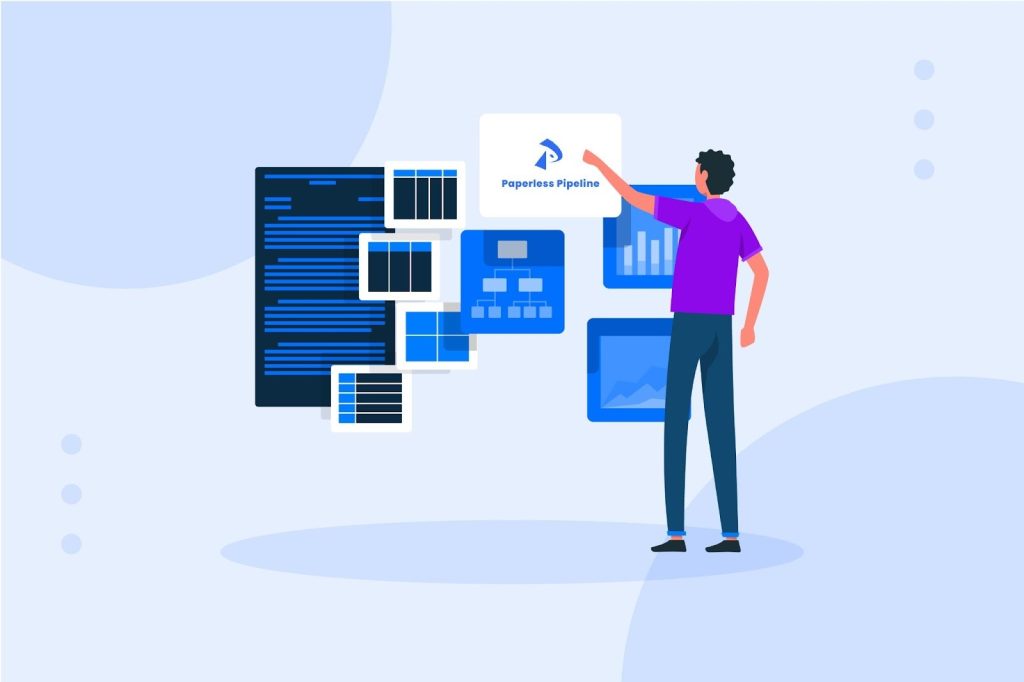
Here are the most important features of Paperless Pipeline and how our platform can help real estate professionals manage more than just project schedules:
Centralized transaction dashboard
A core feature of Paperless Pipeline is our transaction dashboard, which acts as a central hub where users can oversee all open, pending, and closed deals in one place.
Key data fields, including property address, agent name, close date, commission, and deal status, represent each transaction.
Transactions are easy to filter, sort, and search, making it simple for users to locate the exact deal they need, even when managing high volumes.
This dashboard allows real estate teams to do more than just track projects; you get to see deals at every stage of your pipeline.
Whether you’re processing a new listing, tracking contingency removals, or preparing to close, the platform gives you real-time visibility across your entire portfolio.
Smart checklists and custom workflows
Every transaction in Paperless Pipeline can include a fully customizable checklist that reflects your team’s unique workflow.
These checklists go beyond basic to-do lists and inform each transaction’s compliance, ensuring every step is completed and documented correctly.
You can create reusable checklist templates for various transaction types, including listings, buyer sides, and referrals, and assign tasks with due dates, responsible team members, and automated reminders.
For teams handling multiple transactions, these checklists can help you enforce consistency and eliminate missed steps.

Integrated eSignature solution
One of the most significant new additions to our platform is Pipeline eSign, a fully integrated eSignature tool that eliminates the need for third-party signing platforms.
This feature is seamlessly embedded within the platform, allowing users to send, sign, and manage documents without ever leaving Paperless Pipeline.
Pipeline eSign supports legally binding electronic signatures and includes all essential capabilities.
As it’s built directly into the transaction management flow, Pipeline eSign saves time, reduces errors, and improves security.
For real estate professionals who previously relied on tools like DocuSign or HelloSign, Pipeline eSign creates a streamlined alternative that reduces app switching and is more cost-effective.

Create, fill, and send real estate forms
Another powerful addition to Paperless Pipeline is our new Forms feature, which enables you to generate, fill out, and send standardized real estate forms within the platform.
Whether you’re working with purchase agreements, disclosures, or listing forms, Forms simplifies the data entry process and keeps everything in one place.
The Forms feature supports smart form fields that auto-populate with transaction data and integration with checklists and document folders.
This feature is especially valuable for agents and transaction coordinators working across multiple listing services (MLS) areas or needing to comply with regional form requirements.
It allows you to standardize processes while staying flexible to nuances, which is something that’s not easily achieved with other tools or general project apps.

File sharing and document management
Paperless Pipeline allows users to upload, organize, and store an unlimited number of documents per transaction.
Each file is attached to a specific deal and placed into a customizable folder structure, allowing users to maintain order and meet compliance requirements with minimal effort.
File sharing is also simple and secure. You can grant permission-based access to buyers, sellers, lenders, escrow agents, and cooperating brokers without giving them access to the full transaction.
The platform supports version tracking, file replacement, and document expiration reminders, helping teams stay on top of time-sensitive paperwork.
Task management for individuals and teams
While the transaction checklist helps manage the process as a whole, Paperless Pipeline also lets users create tasks for individuals, ensuring that everyone on the team is aware of their responsibilities and deadlines.
Tasks can be assigned to agents, admins, transaction coordinators, or external contacts, and include due dates, notes, and follow-up reminders.
This structure supports both centralized and decentralized team models, giving brokers and team leads visibility into what everyone is working on.
By tracking open tasks across all deals, managers can spot bottlenecks early and redistribute workloads as needed.

Agent activity tracking and accountability
Paperless Pipeline helps brokerages maintain oversight of agent activity without micromanaging. Each action on a transaction is logged, giving admins and managers a complete history of who uploaded, reviewed, signed, or modified documents.
This audit trail is essential for risk management and is highly important for compliance.
Brokerages can review each agent’s productivity, task completion, and responsiveness, all without needing to dig through emails or complex spreadsheets.
Commission management and financial oversight
Another useful feature is Paperless Pipeline’s built-in commission tracking. Through our Commission Module, each transaction can include detailed commission information for everyone involved, including split percentages, referral fees, broker fees, and custom deductions.
These values are automatically calculated and tied to deal milestones, simplifying payment processing.
Brokers can also generate reports to track income, forecast commissions, and reconcile expected payouts. This makes Paperless Pipeline more than just a workflow tool; it’s also a financial management asset.

Custom fields for flexible data tracking
Real estate teams don’t all work the same way. That’s why Paperless Pipeline includes custom fields that can be added to transactions.
These fields enable teams to track additional information, such as marketing budgets, inspection deadlines, staging details, or any other data points that matter to their workflow.
Custom fields can be made mandatory, conditionally visible, or integrated into checklists and tasks. This ensures your team captures the exact information they need to work efficiently.
This flexibility is a big part of what makes Paperless Pipeline the best Trello alternative for teams who need structure but can’t be boxed in by rigid templates.
Team messaging and collaboration tools
Effective real estate teams rely heavily on communication. Paperless Pipeline includes robust collaboration features that eliminate the need for email chains, text threads, and fragmented updates.
Users can leave notes on individual transactions, tag teammates, or send real-time alerts about document changes or task status.
Notifications are customizable by user role and preference, so transaction coordinators can stay looped in without being overwhelmed.
Robust reporting and analytics
Paperless Pipeline offers a suite of reporting tools that give teams actionable insights into performance and productivity.
Reports can be run for transaction volume by agent or office, close rates by types of transactions, commission income over time, checklist completion dates, and document compliance status.
These reports can be exported or scheduled to send automatically, helping brokers make data-driven decisions.
The platform also supports report customization, allowing you to filter and sort based on any field in the system, including your custom fields.

Integration with other tools
While Paperless Pipeline is a robust, all-in-one transaction management platform, it also integrates with other popular tools commonly used in the real estate industry.
Through Zapier, you can connect over 3,000 of your favorite apps to Paperless Pipeline. This integration-friendly approach ensures that teams don’t have to abandon the platforms they love.
Instead, they can centralize their workflow in Paperless Pipeline while still leveraging the best apps they’re already using.
Mobile access and responsive design
Paperless Pipeline is fully cloud-based and accessible from any device with an internet connection.
The platform is mobile-optimized, enabling agents and transaction coordinators to upload documents, check on tasks, or share files on the go.
This flexibility ensures that remote teams and agents in the field can stay connected to their transactions no matter where they are.
It also allows everyone to work in real-time, even while traveling or away from the office.
Security and compliance are built in
Security is a critical concern in real estate, where sensitive client information and legal documents are exchanged all the time.
Paperless Pipeline features role-based access control, encrypted file storage, detailed activity logs for auditing, and permission-based document sharing.
This extra protection makes sure that every action in the system is documented and traceable, which, as you know, is key for meeting industry regulations and compliance standards.

Simple onboarding and scalable setup
Unlike many enterprise platforms that need long implementation times, Paperless Pipeline is known for its fast setup and ease of onboarding.
Teams can get started in just a few hours and tailor the platform as they go. Our onboarding resources, training materials, and support teams can help you quickly adapt to the system. Plus, admins get free training, and we don’t charge any fees to get you all set up.
Flexible user roles and permissions
Paperless Pipeline allows for detailed control over who can see and do what within the system. Roles can be customized for brokers and team leads, admins and transaction coordinators, agents, and external collaborators.
This flexibility means that users can access only what they need, helping to prevent accidental changes, access to the wrong information, or data leaks.
Permission controls are vital for real estate teams managing dozens or even hundreds of transactions across multiple offices.
The Pros and Cons of Using Trello for Transaction Management

It’s important to understand the advantages and limitations of using Trello as a transaction management tool before investing in the platform. Here’s a breakdown of these:
Pros
Generous free plan for small teams
One of Trello’s more attractive advantages is its free plan, which allows up to 10 collaborators per workspace. This makes it appealing to solo transaction coordinators, small real estate teams, or those just getting started with digital workflow tools.
The free version includes some of its main features, such as boards, lists, cards, due dates, file attachments, and limited Power-Ups, which may be enough for simple workflows.
Intuitive visual layout
Trello’s card-and-board format offers a simple system for organizing transaction steps.
Agents and transaction coordinators can view task progress at a glance by moving cards between labeled lists. This layout can help users quickly assess where each deal stands, without navigating complex menus.
Flexible structure for workflow management
Trello supports custom lists, labels, tags, and due dates, giving users a flexible way to build their own workflows.
This allows teams to create deal stages, client follow-ups, or compliance steps using Trello’s built-in tools. This may help turn the platform into a lightweight workflow management system.
Integrations and Power-Ups
Trello connects with a wide variety of tools through its Power-Ups system. These integrations allow real estate teams to link their transaction documents, notifications, and scheduling tools to their boards, improving overall project management efficiency.
Device and platform accessibility
Trello is cloud-based and accessible from any device with a browser or mobile app. This makes it easy for agents to update tasks, add notes, or check on deals while in the field.
Cons
Not built for real estate
While Trello can be customized to support a transaction workflow, it has not been designed with real estate in mind.
There are no built-in tools for managing documents specific to real estate, like compliance forms, commission tracking, or eSignatures.
Users will need to put together external tools to achieve the functionality they need, which can result in a disjointed system and more room for error.
Limited depth in project management
Trello excels at organizing simple task lists, but when it comes to managing multiple complex deals with dozens of steps, dependencies, and deadlines, it becomes limited.
There’s also no native support for advanced reporting, transaction audits, or document version tracking. These are all features that are critical for real estate project management.
Per-user pricing can get expensive
While the free version of Trello is suitable for small teams, scaling with this platform is expensive due to its per-user pricing model.
As your real estate team grows and needs access to automated workflows, customization, and security features, they need to upgrade to paid plans.
Each new user added to the system increases your monthly cost, making Trello less appealing for brokerages with bigger teams or external collaborators.
Many features are locked behind paid plans
Trello’s free tier includes only a limited number of Power-Ups and automation capabilities. If teams want to access custom fields, timeline views, granular permissions, or advanced checklists, they need to subscribe to premium plans.
Lacks real estate-specific support
Trello doesn’t offer industry-specific support, training, or templates needed by transaction coordinators, brokers, or agents.
With out-of-the-box solutions like Trello, teams need to spend extra time configuring boards or searching for third-party templates, many of which may not deliver the same features or structure needed to manage deals effectively.
The Pros and Cons of Using Paperless Pipeline for Transaction Management

Below, we unpack the advantages and disadvantages of choosing Paperless Pipeline as an alternative to Trello for transaction management:
Pros
Designed specifically for real estate workflows
Unlike general project management platforms that need heavy customization, our tool has been built with real estate teams in mind.
Every feature, including checklists and document folders for agent oversight and commission tracking, is tailored to support the transaction process from listing to close.
This industry focus means that users can implement the platform quickly at their brokerage, without needing to build custom structures or rely on third-party plugins to manage real estate-specific tasks.
No per-user fees and unlimited users
Another benefit of choosing Paperless Pipeline is our pricing model. All our plans allow for unlimited users, regardless of your team size or role.
There are no per-user fees, which is a significant advantage over Trello, which charges per additional user.
This makes our platform especially cost-effective for brokerages with larger agent rosters, growing teams, or those who work with external collaborators.
Everyone can be looped into the system without increasing your monthly cost.
Scales seamlessly for teams of any size
Whether you’re a solo transaction coordinator handling 10 deals a month or a multi-office brokerage closing 500 transactions, Paperless Pipeline is built to scale with you.
Our flexible pricing structure, which we will discuss in more detail later, means you only pay for the number of transactions you handle each month and nothing more. Plus, you get access to all our features, no matter which plan you’re on.
Highly customizable without being overwhelming
Our platform strikes a balance between structure and flexibility. You can set up custom transaction fields, task types, and documents that match your existing processes.
There’s no need to set up an entire system from scratch. Paperless Pipeline provides a foundation while still allowing for workflow personalization.
Streamlined communication and role-based permissions
Transaction notes, file comments, and internal alerts allow team members to communicate clearly without needing to refer to emails or messaging apps.
Additionally, because our platform supports detailed role-based permissions, brokers can ensure that each user sees what they need to, whether that’s a full view of all transactions or access limited to their own deals.
Comprehensive compliance and audit trail tool
In an industry where documentation and deadlines matter, our tool excels at keeping teams accountable. Every action is logged, timestamped, and traceable, making it easy to prepare for audits or respond to disputes.
From listing agreements to commission disbursement forms, every file and step is captured in one place with a full activity log.
Excellent support and onboarding resources
We’ve earned a reputation for excellent customer support over the years. Our clients receive onboarding guidance, access to a detailed knowledge base, and fast responses from our support staff.
Whether you’re new to Paperless Pipelie or you want to customize your account as you scale, you’ll find responsive help at every stage of your journey.
A 14-day free trial
You can access a full-featured, 14-day free trial of Paperless Pipeline with absolutely zero commitment. There’s no need to provide us with your credit card information, and we won’t surprise you with any charges at the end of your trial or pressure you into investing in our platform.
It’s a risk-free way to explore everything Paperless Pipeline has to offer, just like you would if you were a paying customer, including all the tools trusted by over 90,000 brokerages, like advanced document management, task tracking, transaction coordination features, and our new Pipeline eSign and Forms tools.
Unlike many other platforms that limit functionality in trial mode, we provide unrestricted access to our tool, allowing you to see how well it integrates into your existing workflow.
We also offer free setup support during your trial, whether it’s importing your transactions, setting up your checklists, or training your admins. This makes it easier to hit the ground running and get a real feel for how our platform works in a live environment.
Cons
No free plan
While we offer exceptional value and transparency in our pricing, we don’t offer a free plan.
This could be a potential drawback for very small teams or independent transaction coordinators who are just starting and are comparing options based solely on cost.
However, our pricing is transaction-based and includes all users, so for teams handling even a small volume of transactions, this cost is often quickly offset by increased efficiency and reduced need for multiple tools.
Not ideal for non-real estate project management
As Paperless Pipeline is designed specially for real estate transaction workflows and not for project managers, it isn’t the right fit for teams looking to manage unrelated or internal company operations.
While we offer powerful tools for document and task management, our platform doesn’t include project management features, such as marketing campaign planning.
Trello Pricing

Trello includes four pricing plans:
- Their first plan is completely free for up to 10 collaborators per workspace.
- The standard plan is $5 monthly per user and includes unlimited boards, card mirroring, and more automation features.
- Trello’s premium plan is $10 per user per month and includes AI features, admin controls, and more ways to view projects.
- Their enterprise plan is $17.50 per user per month for 50 users, and this amount increases per user. With this plan, you get enterprise-grade security and controls.

Paperless Pipeline Pricing
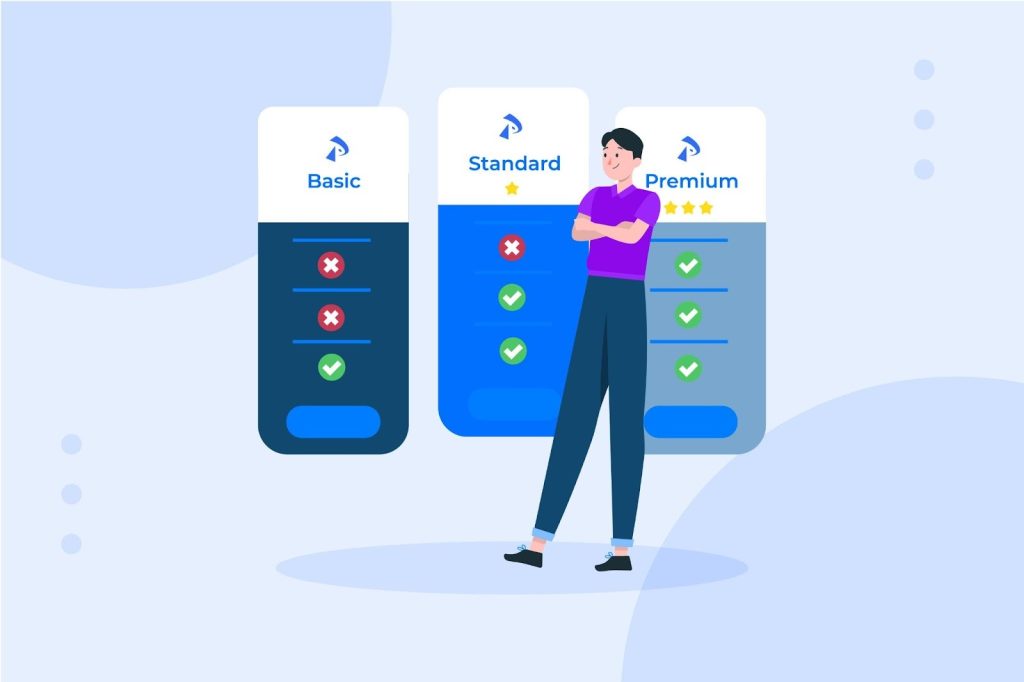
Our pricing is transaction-based, meaning you only pay for the number of new monthly transactions you deal with.
Pricing starts from as little as $65 per month for five transactions, $175 for 25 transactions, and ranges up to $495 for 250 transactions.
We also offer an Unlimited Plan for brokerages that need more than 250 new transactions per month, priced at $675 monthly, with the price for each new transaction after 450 being just $1.50.
Included in our pricing is everything you need to get started, including free account setup, free admin training, and free transaction import. You’ll also get unlimited storage, users, and locations with each plan.
We also don’t tie you into any annual contracts, and you can upgrade, downgrade, or cancel at any time.

Which Platform Is More Suitable for Transaction Management?
Below is a summary of both Trello and Paperless Pipeline when it comes to how suitable they are for transaction management:
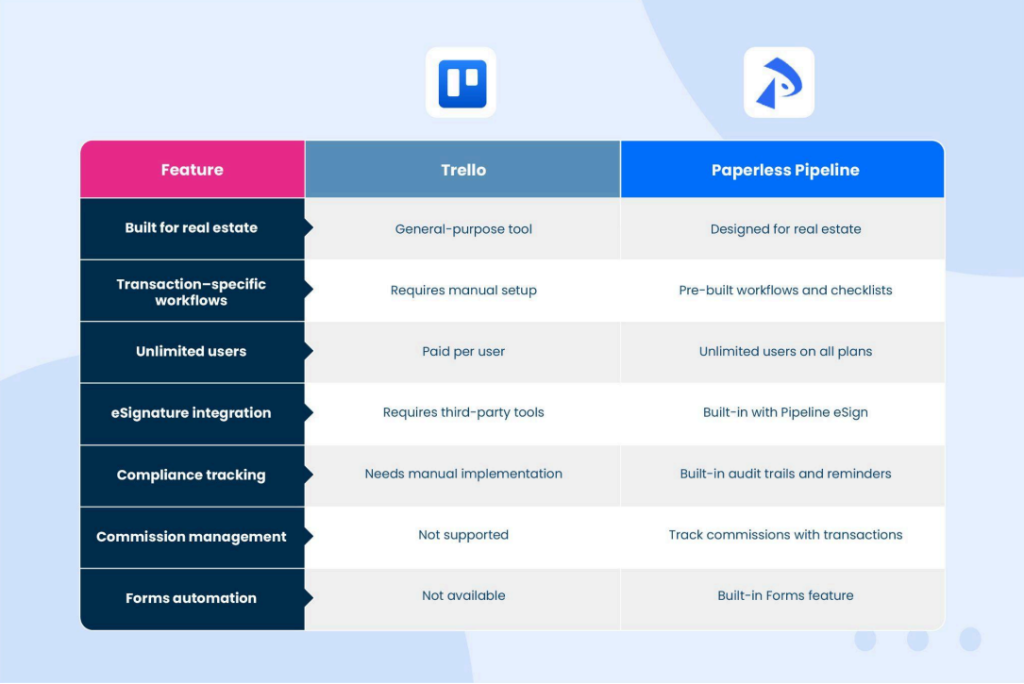
Try the Best Trello Alternative for Free for 14 Days (No Credit Card Required)
If you’ve outgrown Trello and find yourself spending more time customizing workarounds than managing transactions, it might be time to invest in a platform designed specifically for real estate.
Paperless Pipeline gives brokers, transaction coordinators, agents, and admins a powerful alternative to general project management tools without the clutter, limitations, or per-user pricing.
With features designed specifically for real estate workflows, you can streamline your checklist processes, organize documents, track task progress, and collaborate with your entire team in one place.
You don’t need to commit to anything to experience the difference. Start your free 14-day trial of Paperless Pipeline and see how easy transaction management can be when your software works the way your team does.